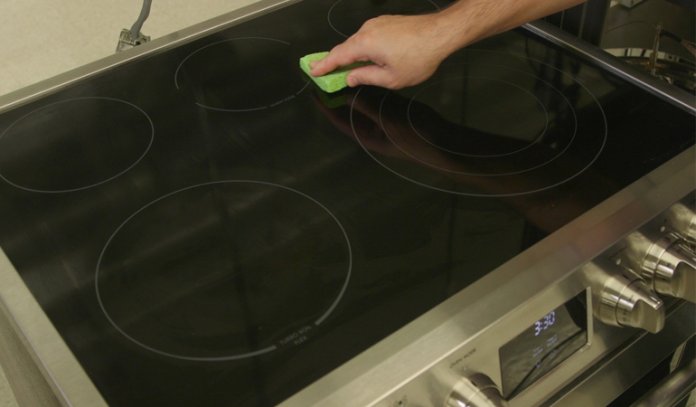Glass cooktops are popular with homeowners because they look sleek and modern. That flat, smooth top also means you can’t get rid of burnt food by popping the mess into the dishwasher, the way you can with burner coils and drip pans. But that’s okay because you don’t have to worry about burnt food causing permanent stains, either.
To get your glass stovetop looking new again, you need a little elbow grease and a few ingredients you’ve already got in the kitchen.
Cleaning Glass or Ceramic Stovetops
Although we call smooth cooktops “glass,” they’re really a blend of glass and ceramic materials designed to withstand temperature changes. So, while few things scratch actual glass, that can’t be said of ceramic glass cooktops. That’s why it’s important to clean these flat stovetops properly, or you can wind up with a costly eyesore.
How to Get Burnt Food off of Glass Stovetops
You need a bit more than elbow grease to deal with stubborn food stains on glass cooktops. The steps below use kitchen ingredients but if you want to use a commercial product, make sure it’s designed for use on glass stovetops. Bar Keeper’s Friend makes a great one. Or use a damp Magic Eraser and water with a little Dawn dish soap.
- Take a bowl
In a bowl, combine 1/2 cup baking soda with 2 tablespoons of water to form a paste. Spread this onto your glass cooktop with a sponge or cloth.
- Fill a spray bottle
Fill a spray bottle with straight white vinegar and spritz it onto the stovetop. The foaming reaction between the baking soda and vinegar helps separate the bond between burnt food and your cooktop.
- Use a old toothbrush
When the foaming stops, grab a damp microfiber cloth and rub in circular motions to remove loosened particles. Use an old toothbrush to clean around the edges and a plastic scraper to pry up stubborn residue. If the mess isn’t loosened yet, cover the cooktop with damp, warm towels for 10-15 minutes, then proceed.
- Wipe away any residue
Wipe away any residue, then go over the surface one more time with a clean, damp microfiber cloth. Buff dry for a streak-free shine.
Common Questions About Cleaning Glass Stovetops
Replacing a glass cooktop is expensive, so it’s important you don’t use cleaners or methods that could permanently scratch or etch it. That’s not the only concern when it comes to cleaning your stovetop, though. You also need to avoid using products that could be harmful to your health.
Although it sounds like they’d work, glass cleaners aren’t designed for use on glass cooktops. Some, like Windex, are ammonia-based and can damage the trim or edging around your cooktop. Others can cause permanent discoloration.
A popular cleaning hack involves using a safety razor to get burnt food off of glass stovetops, but most cooktop manufacturers caution against it.
Razors won’t scratch pure glass, but your cooktop is a mixture of glass and ceramic materials that razors can scratch. (Manufacturers also caution against using cast iron cookware on your glass stovetop for the same reason.) Plastic scrapers or old credit cards are much better alternatives that won’t ruin your cooktop.
Car wax is a great way to keep metal automobile surfaces shiny, but using it on your cooktop can be dangerous. It’s not designed to withstand such high temperatures, so it may permanently discolor your cooktop. Car wax doesn’t rub off completely, either — that’s how it helps keep your car shiny — and the residue it leaves on your stove will produce harmful fumes when heated. So, don’t fall for that stovetop cleaning hack, either.
To keep your glass cooktop clean throughout the week, use lids or splatter shields when cooking and wipe up spills as they happen. Then, make a point of using the homemade cooktop cleaning spray as part of a daily tidy-up routine and follow these steps to remove cooked-on food as needed.


